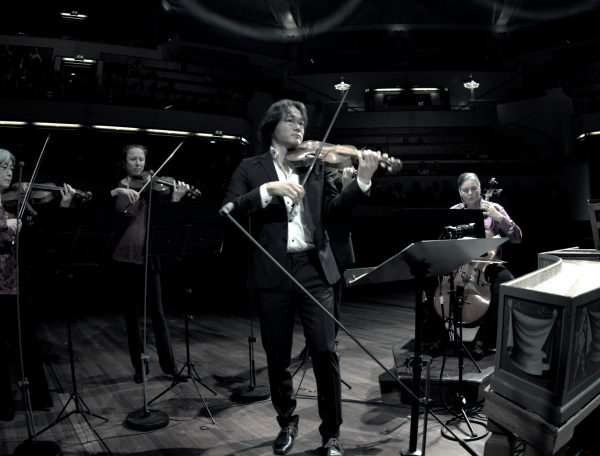

'Brandenburg' Concerto No. 5 in D major
BWV 1050 performed by the Netherlands Bach Society
conducted by Shunske Sato
TivoliVredenburg, Utrecht
Behind the music
In the sunlight
The harpsichord emerges as a solo instrument
In March 1721, Bach sent a manuscript from Köthen to Berlin entitled ‘Six concertos with several instruments’ (Six concerts avec plusieurs instruments), dedicated to Christian Ludwig (1677-1734), Margrave of Brandenburg-Schwedt. In the preface, Bach stated that he had played for the margrave ‘a couple of years ago’ and had promised to send him ‘some of his compositions’. That was probably during a visit to Berlin in March 1719, when Bach had travelled to the Prussian capital to take receipt of a new harpsichord for the court in Köthen. The music that he sent to the margrave a couple of years later (which subsequently became known as the 'Brandenburg' Concertos) was Bach’s ultimate view of the most important large-scale instrumental genre of his day: the concerto.
A concerto nearly always involves a solo instrument (or combination of solo instruments) and an ensemble. The key idea is the alternation between one or more soloists and the whole ensemble, in a sort of light-hearted competition. In the six 'Brandenburg' Concertos, Bach explores every facet of this genre, with regard to both instrumentation and the way in which he handles the form. All the traditionally used string and wind instruments appear as soloists. And in this Fifth Concerto the harpsichord emerges as a soloist rather than an accompanying instrument.
In this performance, an early version (BWV 1050a) of this cadence is played, which is shorter than the later version. Both versions share some of the same material, that recalls the character of certain youthful fantasias by Bach (such as the Chromatic Fantasia). If the longer version (BWV 1050) compensates for the almost stormy material with a long introduction full of light and a conclusion full of hope, this shorter version (BWV 1050a) has unique passages, such as those dizzying chromatic descending scales, difficult to find in other works by Bach.
'Brandenburg' concertos, BWV 1046-1051
In March 1721, Bach sent a manuscript from Köthen to Berlin entitled ‘Six concertos with several instruments’ (Six concerts avec plusieurs instruments), dedicated to Christian Ludwig (1677-1734), Margrave of Brandenburg-Schwedt. In the preface, Bach stated that he had played for the margrave ‘a couple of years ago’ and had promised to send him ‘some of his compositions’. That was probably during a visit to Berlin in March 1719, when Bach had travelled to the Prussian capital to take receipt of a new harpsichord for the court in Köthen. The music that he sent to the margrave a couple of years later (which subsequently became known as the 'Brandenburg' Concertos) was Bach’s ultimate view of the most important large-scale instrumental genre of his day: the concerto.
A concerto nearly always involves a solo instrument (or combination of solo instruments) and an ensemble. The key idea is the alternation between one or more soloists and the whole ensemble, in a sort of light-hearted competition. In the six 'Brandenburg' Concertos, Bach explores every facet of this genre, with regard to both instrumentation and the way in which he handles the form. All the traditionally used string and wind instruments and the harpsichord appear as soloists, the musical forms range from court dances to near-fugues, and the relationship between the solos and tutti instruments is always shifting. Together, the six concertos thus form a virtuoso sample sheet of the Baroque concerto.
- BWV
- 1050a
- Title
- Concerto in D major
- Epithet
- 'Brandenburg' Concerto no. 5
- Instrument
- harpsichord, traverso
- Genre
- orchestral works
- Serie
- Brandenburg concertos
- Year
- 1719-1720
- City
- Köthen (but possibly earlier in Weimar)
- Occasion
- Dedicated in 1721 to Margrave Christian Ludwig of Brandenburg
Extra videos
Vocal texts
Original
Translation
Credits
-
- Release date
- 12 May 2022
-
- Recording date
- 2 October 2018
-
- Location
- TivoliVredenburg, Utrecht
-
- Violin and direction
- Shunske Sato
-
- Harpsichord
- Diego Ares
-
- Traverso
- Marten Root
-
- Violin 2
- Anneke van Haaften
-
- Viola
- Staas Swierstra
-
- Cello
- Lucia Swarts
-
- Double bass
- Robert Franenberg
-
- Director and editor
- Lucas van Woerkum
-
- Music recording
- Guido Tichelman, Bastiaan Kuijt, Pim van der Lee
-
- Music edit and mix
- Guido Tichelman
-
- Camera
- Robert Berger, Nina Badoux, Joas Burggraaf, Jasper Gheluwe
-
- Lights
- Zen Bloot
-
- Assistant director
- Stijn Berkhouwer
-
- Assistant music recording
- Marloes Biermans
-
- Set technique
- Alex de Gier
-
- Project manager videobrix
- Peter Hazenberg
-
- Producer concert
- Marco Meijdam
-
- Producer film
- Jessie Verbrugh
'Brandenburg' Concerto no. 5 in D major
Two versions of 'Brandenburg' Concerto no. 5 have been recorded. An earlier version (BWV 1050a) and a later version (BWV 1050). You can view both recordings here.
Discover
Help us to complete All of Bach
There are still many recordings to be made before the whole of Bach’s oeuvre is online. And we can’t complete the task without the financial support of our patrons. Please help us to complete the musical heritage of Bach, by supporting us with a donation!



